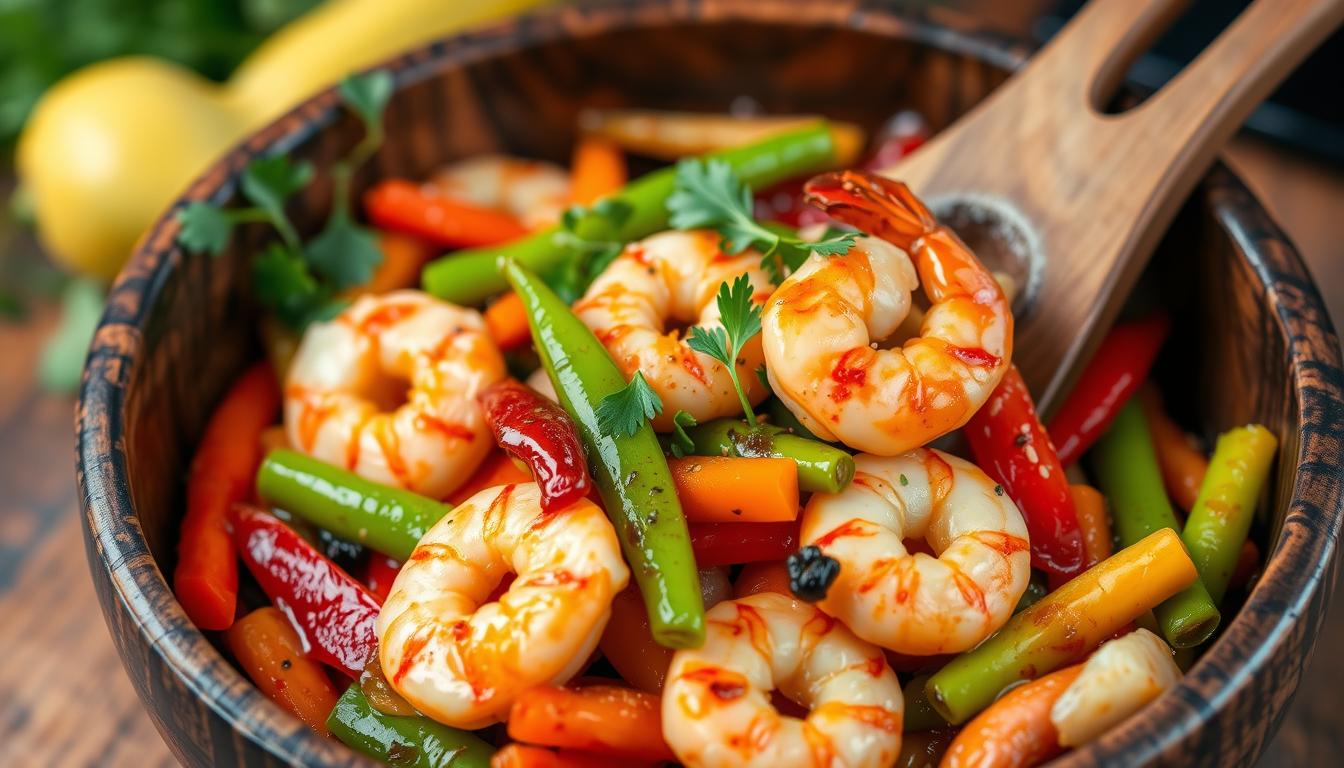Do you live with chronic pain and fatigue from fibromyalgia? You might be surprised to find that a simple shrimp and vegetable stir-fry could be your new favorite meal. A shocking one-third of people are at risk for iodine deficiency, which can make fibromyalgia symptoms worse. This quick and easy recipe is full of anti-inflammatory ingredients that can help manage your condition while giving you a delicious meal.
Find out how this fibromyalgia-friendly dish can support your health and give your body the nourishment it needs. Let’s explore the details of this recipe and the benefits of an anti-inflammatory diet for managing your fibromyalgia symptoms.
Shrimp and Vegetable Stir-Fry: A Fibromyalgia-Friendly Meal
Living with fibromyalgia can make finding good meals hard. But shrimp and vegetable stir-fry is a tasty fix. It has lean protein, anti-inflammatory veggies, and great flavors to help manage fibromyalgia symptoms.
Studies show that a fibromyalgia diet full of anti-inflammatory ingredients helps. A 2019 review found that diet changes improved sleep and reduced depression/anxiety. Another study found that antioxidant diets led to fewer tender points and better life quality.
The shrimp and vegetable stir-fry includes these good things. Shrimp is a lean protein with all nine essential amino acids. The veggies, like leafy greens, bell peppers, and onions, are full of fiber, vitamins, and minerals to fight inflammation.
Choosing this shrimp and vegetable stir-fry for fibromyalgia means you get a healthy, tasty meal. It’s quick to make and you can change the ingredients to fit your taste. It’s a great choice for your fibromyalgia-friendly meals.
Shrimp and vegetable stir-fry for fibromyalgia
If you have fibromyalgia, adding a shrimp and vegetable stir-fry to your meals can help. The shrimp’s lean protein and the veggies’ anti-inflammatory effects make it a great choice. This dish can help reduce inflammation and ease chronic pain and fatigue.
This recipe is made with ingredients that are good for fibromyalgia. The shrimp is rich in iodine, which is good for your thyroid. The veggies add vitamins, minerals, and antioxidants. Plus, it’s gluten-free, dairy-free, and low in carbs, so you can feel good about eating it.
- Shrimp – a lean protein source rich in iodine and other beneficial nutrients
- Assorted vegetables – such as mushrooms, snow peas, and green onions for their anti-inflammatory properties
- Garlic and ginger – for their natural anti-inflammatory effects
- Healthy fats – like those found in coconut aminos, a soy sauce alternative
By adding this shrimp and vegetable stir-fry to your fibromyalgia diet, you’re taking a step towards better health. It’s a way to manage your symptoms and improve your overall well-being.
Benefits of an Anti-Inflammatory Diet for Fibromyalgia
If you have fibromyalgia, trying an anti-inflammatory diet might ease your symptoms. This diet includes foods that fight inflammation. This is important because inflammation is linked to fibromyalgia’s pain and tiredness.
Omega-3 Fatty Acids Help Reduce Inflammation
Omega-3 fatty acids are key in an anti-inflammatory diet for fibromyalgia. Shrimp is a great source of these fats. Eating more omega-3s can lower inflammation and help with pain and other symptoms.
Low-Glycemic Index Foods Stabilize Blood Sugar
Low-glycemic index foods are also important in this diet. These carbs don’t raise blood sugar too much. They give steady energy and help keep blood sugar stable. This is good for people with fibromyalgia, who often feel tired and have energy ups and downs.
By eating anti-inflammatory foods, you might feel better from fibromyalgia. You could also live a better life overall.
Nutrient-Dense Ingredients in This Stir-Fry Recipe
This shrimp and vegetable stir-fry is full of nutrients. It’s great for people with fibromyalgia. The shrimp is a lean protein that fights inflammation.
The stir-fry also has anti-inflammatory veggies like snow peas, broccoli, and bell peppers. These veggies are rich in fiber, vitamins, and minerals. They also have antioxidants that fight oxidative stress in fibromyalgia.
Other ingredients add even more nutrition. For example:
- Tofu, a plant-based protein with minerals like calcium, iron, and magnesium.
- Brown rice, a whole grain with complex carbs, fiber, and B vitamins.
- Coconut aminos, a soy sauce alternative with less sodium and no soy or gluten.
This stir-fry is a balanced and nourishing meal. It helps manage fibromyalgia symptoms and supports overall health.
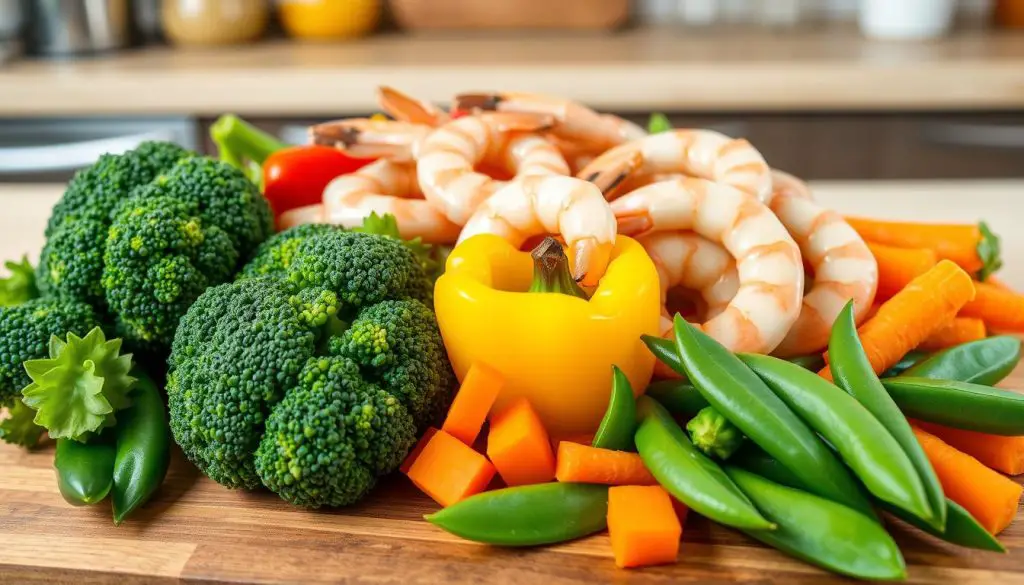
Cooking with Shrimp: A Healthy Protein Choice
Shrimp is a great protein for those with fibromyalgia. It’s low in carbs and high in iodine, which is good for the thyroid. Choose wild-caught shrimp over farm-raised. Wild-caught shrimp are better for you and the planet because they’re not treated with antibiotics or hormones.
Wild-Caught vs. Farm-Raised Shrimp
Farm-raised shrimp might be cheaper and easier to find. But wild-caught shrimp have many advantages:
- Wild-caught shrimp are cleaner and more natural, without antibiotics or hormones.
- Farm-raised shrimp can harm the environment more than wild-caught ones.
- Wild-caught shrimp taste better, with a richer flavor.
When buying shrimp, look for firm, clear shells and a fresh smell. Buying from trusted sources ensures you get a top-quality, healthy protein choice for your meals.
| Nutrient | Amount in 3-ounce Serving of Shrimp |
|---|---|
| Calories | 84.2 |
| Protein | 20.4 grams |
| Omega-3 Fatty Acids | 0.2 grams |
| Iodine | 21.6 micrograms |
Preparing a Quick and Easy Shrimp Stir-Fry
This quick and easy shrimp stir-fry is perfect for those with fibromyalgia. It’s ready in just 30 minutes. This fibromyalgia-friendly meal is easy to make and tastes great.
To make this stir-fry fast, start by getting your ingredients ready. You’ll need shrimp, fresh veggies, and a simple sauce. Then, cooking is quick, and you’ll have a healthy meal ready in no time.
- First, heat a large skillet or wok over medium-high heat. Use a healthy oil like sesame or avocado oil.
- Put your shrimp in the pan and stir-fry for 2-3 minutes. They should start to turn pink and curl. Take them out and set them aside.
- Now, add your chopped veggies to the pan. Stir-fry for 5-7 minutes, until they’re tender-crisp.
- Put the shrimp back in the pan with your fibromyalgia-friendly stir-fry sauce. Stir everything together for 2-3 minutes, until the sauce thickens and the shrimp are cooked.
- Serve your quick and easy shrimp stir-fry over steamed whole grains or fibromyalgia-friendly veggies. Enjoy your tasty and fibromyalgia-friendly meal!
| Recipe | Active Time | Cooking Time |
|---|---|---|
| Quick and Easy Shrimp Stir-Fry | 15 minutes | 15 minutes |
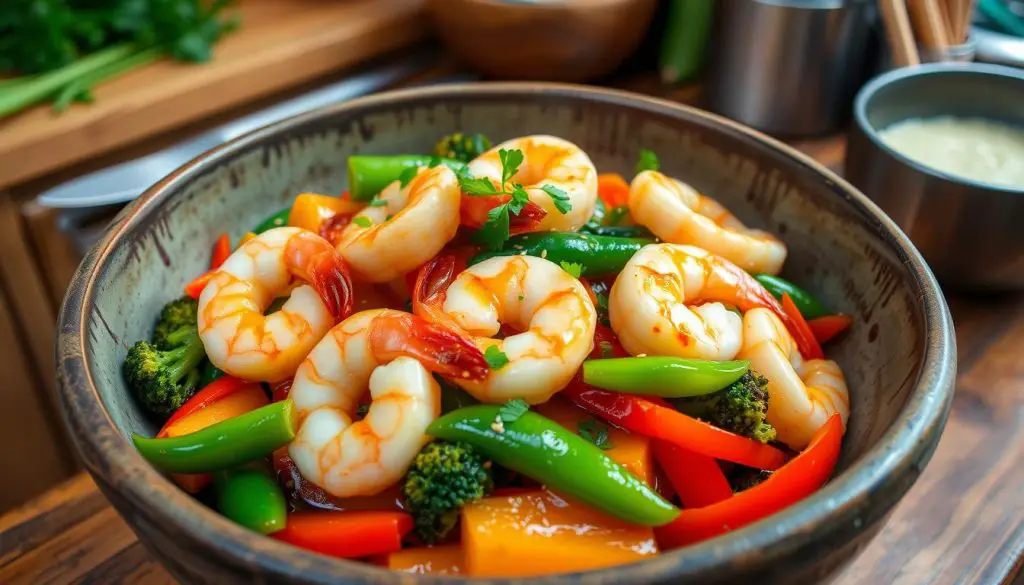
This quick and easy shrimp stir-fry is a great fibromyalgia-friendly meal option. It’s easy to make and packed with nutritious ingredients. Enjoy it anytime!
Customizing Your Stir-Fry with Favorite Vegetables
Stir-fries are great because you can add your favorite veggies. This recipe starts with snow peas, broccoli, and bell peppers. But, you can also add mushrooms, bok choy, or zucchini to make it your own. Try mixing different veggies to find the perfect customized stir-fry for you.
For a fibromyalgia diet, eating a variety of favorite vegetables is important. Veggies are full of vitamins, minerals, and antioxidants. These help fight inflammation and ease symptoms. By choosing your favorite veggies, you get the most nutritional benefits from your meal.
- Try adding sliced mushrooms for their anti-inflammatory properties and rich, savory flavor.
- Incorporate crunchy bok choy or tender spinach leaves for a boost of vitamins and fiber.
- Swap in diced zucchini or summer squash for a dose of hydrating, low-calorie veggies.
Creating a great customized stir-fry is all about finding the right mix of flavors and textures. Keep trying different veggie combinations until you find your ideal fibromyalgia-friendly dish.
Fibromyalgia Management Through Healthy Eating Habits
Eating a shrimp and vegetable stir-fry regularly can help manage fibromyalgia. An anti-inflammatory diet rich in nutrients can lessen symptoms and improve health. Eating healthily is a key part of managing this chronic condition.
Fibromyalgia affects over 3.7 million Americans, says the Arthritis Foundation. Studies show that diet changes can help manage symptoms. For instance, a vegan diet may improve sleep and reduce pain, as found in a Scandinavian Journal of Rheumatology study.
Another study in Clinical Rheumatology found that 42% of patients felt worse after eating certain foods. Keeping a food diary helps identify trigger foods. A study in Clinical and Experimental Rheumatology showed that 84% of patients felt better on an MSG- and aspartame-free diet.
Adopting an Anti-Inflammatory Diet
Switching to an anti-inflammatory diet can help manage fibromyalgia. This diet includes:
- Lean proteins like shrimp, which are a good source of anti-inflammatory omega-3 fatty acids
- Fruits and vegetables rich in antioxidants and phytonutrients
- Whole grains and complex carbohydrates that help stabilize blood sugar levels
- Healthy fats from sources like avocados, nuts, and seeds
By eating these foods, you can help your body fight inflammation and reduce fibromyalgia symptoms.
Healthy eating and an anti-inflammatory diet are powerful tools against fibromyalgia. Focus on whole, nutrient-rich foods and avoid triggers. Work with a healthcare professional to create a diet plan that suits your needs and helps manage your fibromyalgia.
Balancing Flavors in a Stir-Fry Sauce
The secret to a delicious stir-fry is in the sauce’s flavor balance. Traditional soy sauce is common but high in sodium, not great for fibromyalgia management. Coconut aminos is a soy-free seasoning that adds savory flavor without too much sodium.
Using Coconut Aminos as a Soy Sauce Alternative
Coconut aminos come from coconut palm sap and are good for anti-inflammatory diets. They have less sodium, no gluten, and lots of amino acids to fight inflammation. This makes them a healthier choice for stir-fry sauces.
When using coconut aminos, start with 2-3 tablespoons. The flavor is milder than soy sauce. Adjust to taste, adding more for the right salty, savory, and sweet mix.
| Ingredient | Amount |
|---|---|
| Coconut Aminos | 2-3 tablespoons |
| Honey or Maple Syrup | 1-2 teaspoons |
| Grated Ginger | 1 teaspoon |
| Minced Garlic | 2 cloves |
| Sesame Oil | 1 teaspoon |
| Cornstarch or Arrowroot Powder | 1 teaspoon |
| Water or Broth | 1/4 cup |
This stir-fry sauce formula balances flavors in your shrimp and vegetable stir-fry. It uses coconut aminos, sweetener, ginger, garlic, and thickening agents. This creates a sauce that’s good for fibromyalgia and complements your dish well.
Tips for Perfectly Cooked Shrimp Every Time
Getting perfectly cooked shrimp in a shrimp stir-fry is key for a tasty fibromyalgia-friendly meal. With a few easy steps, your shrimp will be tender, juicy, and full of flavor every time.
- Start with high-quality, fresh shrimp. Choose wild-caught shrimp for the best texture and flavor.
- Peel and devein the shrimp before cooking. This helps the shrimp cook evenly and absorb more of the stir-fry sauce.
- Pat the shrimp dry with paper towels to remove any excess moisture. Moisture can cause the shrimp to steam instead of sear.
- Heat your pan or wok over medium-high heat and add a bit of oil. Let the oil get hot before adding the shrimp.
- Cook the shrimp in a single layer, without overcrowding the pan. This allows them to sear and develop a nice caramelized crust.
- Flip the shrimp after about 1 minute, or when they just start to turn pink. Continue cooking for another 1-2 minutes, until they are opaque and cooked through.
- Remove the shrimp from the pan as soon as they are cooked. Overcooked shrimp can become tough and rubbery.
By following these simple tips, you can enjoy perfectly cooked shrimp that complement the other fresh, flavorful ingredients in your fibromyalgia-friendly shrimp stir-fry.
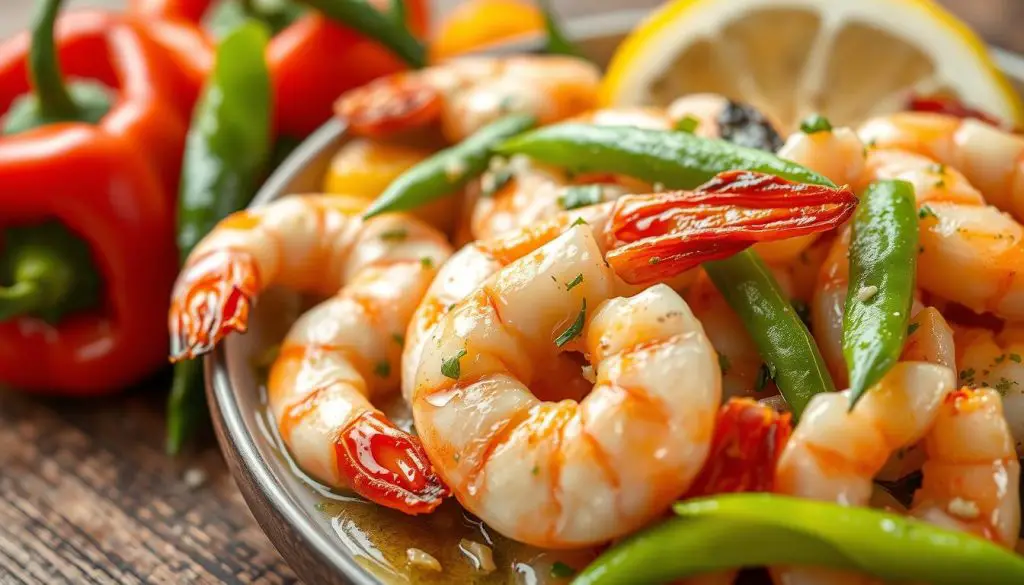
Adding Whole Grains or Noodles to Your Stir-Fry
The shrimp and vegetable stir-fry is tasty and healthy on its own. But, serving it over whole grains or noodles makes it even better. This adds complex carbs and fiber, key for fibromyalgia symptom management.
Choose brown rice, quinoa, or whole wheat pasta for your grains. These slow-digesting carbs keep blood sugar stable and energy up. They’re great for fibromyalgia health.
For noodle lovers, try whole grain noodles or veggie-based noodles like zucchini noodles or shirataki noodles. They make your stir-fry healthier and add more whole grains and veggies.
| Nutrition Facts | Whole Grain Noodles | Veggie Noodles |
|---|---|---|
| Calories | 168 | 55 |
| Total Fat | 7g | 0g |
| Carbohydrates | 23g | 12g |
| Fiber | 3g | 3g |
| Protein | 5.6g | 2g |
Adding whole grains or noodles to your stir-fry makes it more filling and nutritious. It gives your body the carbs and fiber it needs to fight fibromyalgia symptoms. Try it and enjoy the health benefits!
Making Stir-Fries a Weekly Meal Prep Staple
Adding shrimp and vegetable stir-fries to your meal prep can be easy and healthy. You can make a big batch and keep it for the week. This way, you always have a good meal ready, helping you stay balanced and full of energy.
Here are some tips for making stir-fries a regular part of your meal prep routine:
- Prepare the stir-fry ingredients in advance, such as chopping the vegetables and marinating the shrimp.
- Cook a large batch of the stir-fry, enough to serve several meals throughout the week.
- Divide the cooked stir-fry into individual portions and store them in airtight containers in the refrigerator.
- Reheat the stir-fry portions as needed, either in the microwave or on the stovetop, for a quick and nutritious fibromyalgia-friendly meal.
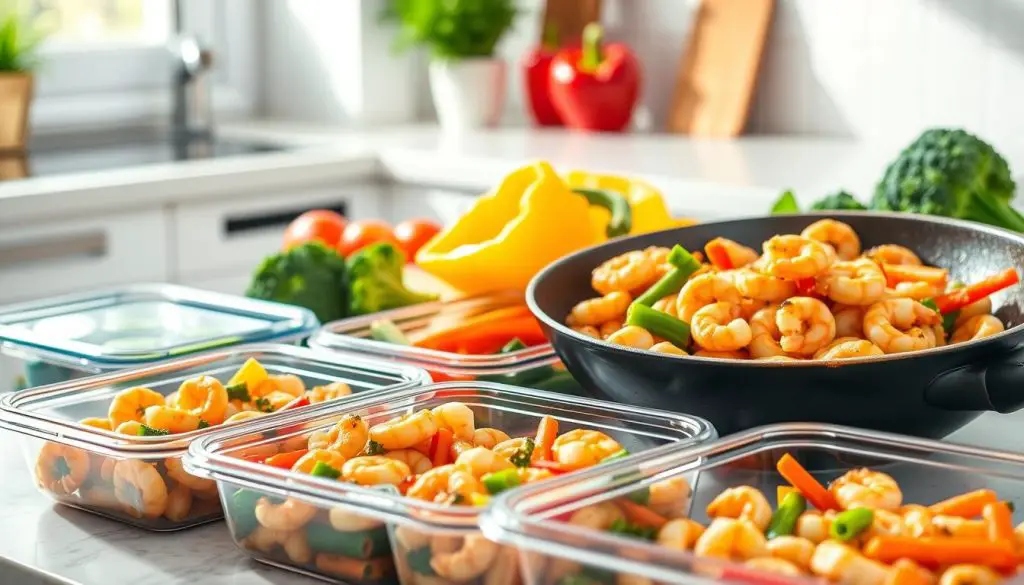
By adding this meal prep trick to your week, you’ll always have a tasty and healthy fibromyalgia-friendly meal. The shrimp and vegetable stir-fry is packed with protein, carbs, and nutrients that fight inflammation. It’s a great way to keep your body healthy and happy.
Modifying the Recipe for Vegetarian or Vegan Diets
If you’re on a vegetarian or vegan diet and have fibromyalgia, you can easily change this shrimp and vegetable stir-fry recipe. Instead of shrimp, try using tofu, tempeh, or a mix of plant-based proteins like edamame, chickpeas, or lentils. Make sure to adjust cooking times and methods so the proteins are fully cooked and the dish tastes great.
For a vegan version, swap the shrimp for plant-based proteins. Firm or extra-firm tofu, marinated and stir-fried, can mimic shrimp’s texture and taste. Or, use a mix of veggies like mushrooms, bell peppers, and zucchini for a filling stir-fry that’s good for a fibromyalgia diet.
Here are some plant-based protein options to consider:
- Tofu: Choose firm or extra-firm tofu and marinate it before stir-frying for extra flavor.
- Tempeh: A soybean-based product that’s firm and nutty.
- Edamame: Fresh, young soybeans that are crunchy and protein-rich.
- Chickpeas: Cooked and seasoned chickpeas add heartiness to the stir-fry.
- Lentils: A versatile legume that boosts the dish’s plant-based protein.
By making these simple swaps, you can enjoy a tasty and healthy vegetarian or vegan shrimp and vegetable stir-fry. It’s tailored to your diet and helps with managing fibromyalgia.
Storing and Reheating Leftover Stir-Fry Portions
Making a tasty shrimp and vegetable stir-fry lets you enjoy it all week. Cool the stir-fry, then put it in airtight containers. Store them in the fridge for up to 4 days.
When you’re ready to eat, you have a few ways to reheat:
- Microwave: Put the stir-fry in a safe dish. Add some broth or water if it’s dry. Heat until warm, stirring now and then.
- Stovetop: Heat the stir-fry in a pan over medium heat. Add a bit of liquid if it’s too dry.
Having healthy, fibromyalgia-friendly meals is important. Reheating stir-fry all week keeps you fed with tasty, nutritious food.
Good storage and reheating keep your stir-fry tasty. Plan ahead and store leftovers for easy fibromyalgia meal prep.
Frequently Asked Questions (FAQ)
Exploring shrimp and vegetable stir-fries can raise some questions. Let’s tackle some common ones to enhance your meal experience.
Can I use frozen shrimp instead of fresh? Yes, you can! Frozen shrimp are easy to find and budget-friendly. Just thaw them first and pat dry before cooking.
What if I don’t like certain vegetables in the recipe? No worries! Stir-fries are flexible. Swap veggies like snow peas, bell peppers, or baby corn. Adjust cooking times based on the veggie.
Is it possible to make this dish ahead of time? Definitely! Stir-fries are perfect for meal prep. Cook, cool, and store in airtight containers for up to 4 days. Reheat in a skillet or microwave when you’re ready.
Source Links
- https://againstallgrain.com/2017/01/17/whole30-shrimp-stir-fry-recipe/
- https://darrellkilcupdc.com/2022/06/healthy-shrimp-stir-fry/
- https://www.verywellhealth.com/fibromyalgia-diet-good-and-bad-foods-4144693
- https://www.eatingwell.com/30-minute-anti-inflammatory-chicken-dinner-recipes-8606692
- https://www.healthline.com/nutrition/paleo-diet-meal-plan-and-menu
- https://grandrapidschiropractic.org/sweet-and-spicy-mushroom-stir-fry/
- https://www.healthline.com/nutrition/healthy-stir-fry
- https://www.healthline.com/health/rheumatoid-arthritis/seven-day-meal-plan
- http://ndl.ethernet.edu.et/bitstream/123456789/36842/1/3125.pdf
- https://www.healthline.com/nutrition/pad-thai-calories
- https://www.aol.com/17-quick-easy-meals-dietitians-161549964.html
- https://nourishingmeals.com/search?updated-min=2016-01-01T00:00:00-08:00&updated-max=2017-01-01T00:00:00-08:00&max-results=12&search=&page=33
- https://www.healthline.com/nutrition/is-shrimp-healthy
- https://inspiralized.com/romesco-garlic-shrimp-with-zucchini-noodles/
- http://caseythecollegeceliac.blogspot.com/2020/12/61-healthy-gluten-free-dinner-recipes-made-30-minutes-or-less.html
- https://www.arthritisfoundationasia.com/arthritis-friendly-recipes.html
- https://www.sarahbush.org/tastytuesdays/
- http://meljoulwan.com/2013/12/29/whole30-2014-week-1-meal-plan/
- https://www.drtereo.com/blog/recipes-for-health-
- https://www.eatingwell.com/article/291150/fibromyalgia-diet-foods-you-should-eat-and-foods-you-should-avoid/
- https://www.womansday.com/health-fitness/nutrition/a56311/going-gluten-free-cured-fibromyalgia/
- https://mylongevitykitchen.com/category/gluten-free/
- https://www.naturopathtoronto.ca/10-delicious-low-carb-dinner-recipes-for-weight-loss/
- https://seafood.lifetips.com/
- https://www.fibrofix.com/pages/21-day-detox
- https://www.fibromyalgiaforums.org/community/threads/adding-seaweed-to-your-diet-for-fibro.21589/
- https://www.momsintofitness.com/wp-content/uploads/2020/01/NOURISH_Moms-Into-Fitness.pdf
- https://dokumen.pub/everything-meals-on-a-budget-cookbook-high-flavor-low-cost-meals-your-family-will-love-9781605502038-1605502030.html
- https://wellnessmama.com/health/autoimmune-diet/comment-page-1/
- https://www.medicalnewstoday.com/articles/323164
- https://www.healthline.com/nutrition/easy-healthy-meals
- https://www.healthline.com/nutrition/can-you-eat-frozen-food-past-expiration-date
- https://www.meritageresort.com/things-to-do-napa-valley-blog
- https://www.weightandwellness.com/resources/articles-and-videos/how-cook-sauteing-vegetables
- https://www.healthline.com/nutrition/is-thai-food-healthy
- https://www.celiac.com/celiac-disease/really-good-chinese-style-fried-rice-gluten-free-r2570/
